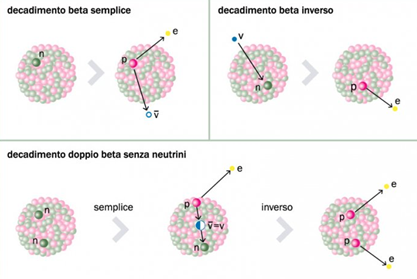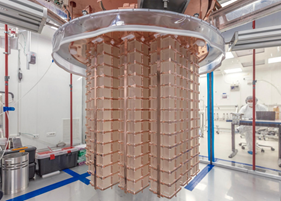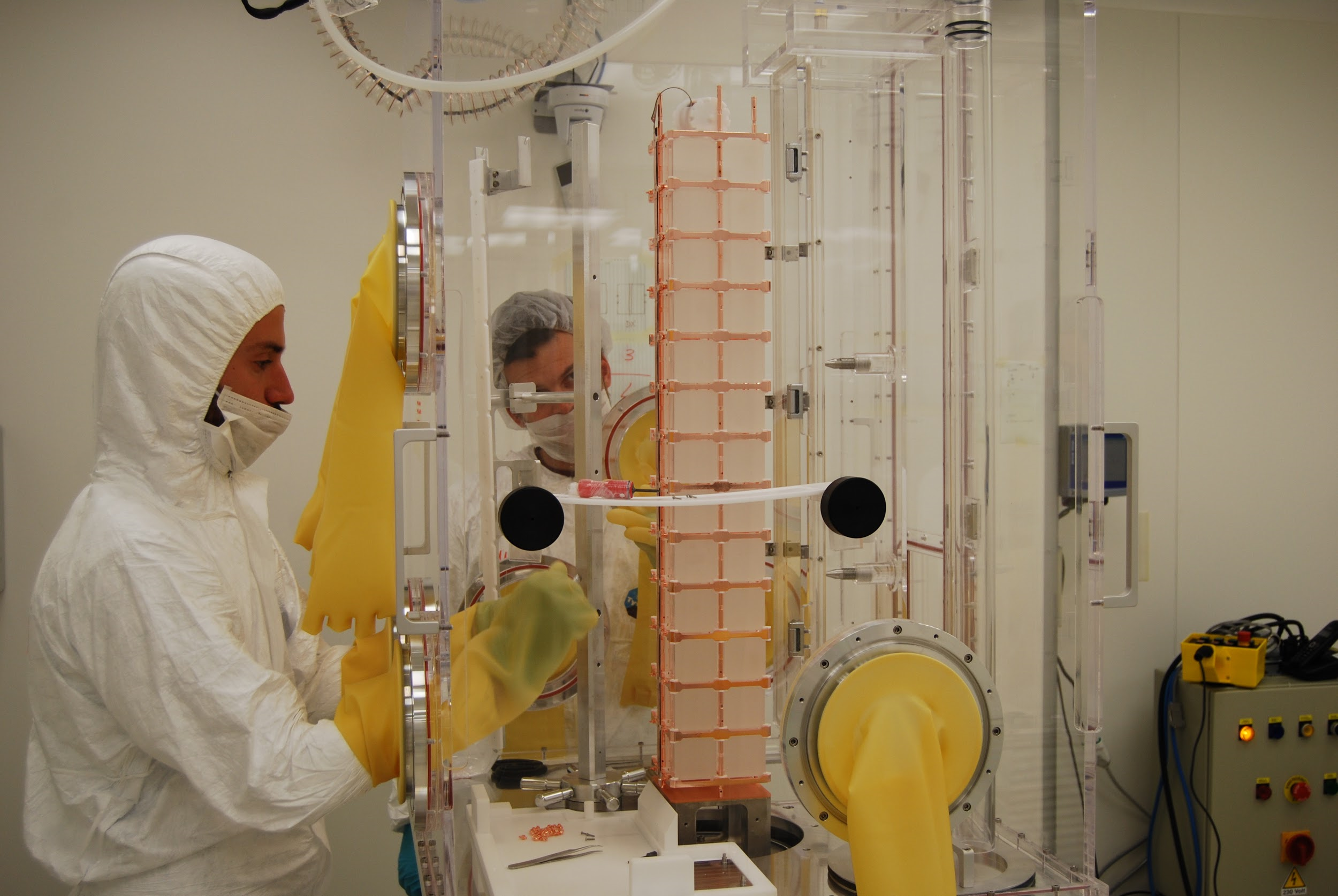
The double beta decay without neutrino emission, it has never been observed.
To observe a double beta decay without neutrino emission could help us to understand the nature of the neutrino.To detect this process pure crystals are used, where any traces of radioactive contamination have been carefully removed.
This type of decay at the moment is only a hypothesis, because it has never been observed. The double beta decay with the emission of two neutrinos has, on the other hand, been identified, although only in a dozen of isotopes.
A beta decay is a process that can occur in two ways, the so-called “direct” and “inverse” decay. In a direct beta decay, a neutron within a nucleus transforms into a proton, emitting an electron and an antineutrino. An inverse decay, on the other hand, can occur when a neutrino from another source, for example the sun, collides, i.e. it interacts, with a neutron of a nucleus and is absorbed, thus transforming into a proton with the emission of an electron (Fig. 1).
The double beta decay with the emission of two neutrinos consists, as the word says, in the “simultaneous” decay of two neutrons of the same nucleus. In the double beta decay without emission of neutrinos, instead, the 2 neutrinos are not emitted. This process occurs if the antineutrino released in a direct decay is instantly absorbed by another neutron of the nucleus, causing an inverse decay (Fig. 1). But … haven’t we just said that inverse decay is caused by a neutrino? That’s precisely the point: if we observe a double beta decay without neutrino it would mean that neutrino and antineutrino behave in the same way and that therefore they are in effect two manifestations of the same particle! This means that there is no distinction between neutrino and antineutrino, as in the case of the electron and its anti-particle the positron. In this case the difference is macroscopic since the electron has a negative electric charge while the positron has a positive electric charge. The neutrino does not have an electric charge, therefore in order to understand if the neutrino and antineutrino are the same particle we need to study this very rare nuclear decay.
A particle that is equal (shows the same behaviour) to its antiparticle is called a Majorana particle, named after the Italian physicist Ettore Majorana, who in the 1930s hypothesized its existence. But why it is so important to try to find out if the neutrino is a Majorana particle or not? Because it could help us in solving one of the most mysterious enigmas of modern physics: to understand why in the Universe there is much more matter than antimatter. In fact, for the Standard Model – the framework that describes the fundamental forces and all the known particles – matter and antimatter have opposite but equivalent properties and there is (apparently) no reason why at the time of the Big Bang they were not created in exact equal quantities. If this were the case, however, we have a paradox: the Universe would have to disappear instantly, since when matter and antimatter come into contact they annihilate each other – that is, they disappear in a flash of energy.
The Standard Model, again, predicts that all known particles behave either as matter or antimatter. However, the neutrino has the right characteristics to be special: if we discover in an experiment that the neutrino and antineutrino are manifestations of a single particle, this could have determined, immediately after the Big Bang, the prevalence that we observe today of matter over antimatter. Moreover, revealing a double beta without neutrino emission would allow us to determine neutrino mass, currently unknown.

Fig.1 The direct beta decay (top left) transforms a neutron (n) into a proton (p), emitting an electron (e) and an antineutrino (ⱴ´). In the inverse beta decay (top right) a neutrino (ⱴ) collides with a neutron (n) producing a proton (p) and an electron (e). In the neutrinoless double beta decay a neutron (n) undergoes a simple decay turning into proton (p) and emitting an electron (e) and an antineutrino (ⱴ´). If antineutrino and neutrino coincide (ⱴ´ = ⱴ) an inverse decay can instantaneously be generated by a “nearby” neutron that absorbs the former neutrino transforming it into a proton (p) with the emission of an electron (e) (Image credits: Asimmetrie.it).
The CUORE experiment estimates that the neutrinoless double beta decay (if it actually exists) should occur in a given nucleus at most once in a septillion (1 followed by 26 zeros) years! In order to observe phenomena of such rarity, it is fundamental to design experiments that amplify as much as possible the occurrence of any event, undisturbed by sources of ''noise'' that confuse the measurements. For this reason, large masses of crystals are used (Fig. 2), since the greater the number of atoms the greater the probability that one of these atoms will decay. The experiments are also located where noise is naturally lower: for example, the 1400 meters of rock above the Gran Sasso National Laboratories (LNGS) at the INFN reduce a millionfold the disturbance caused by cosmic rays. Four experiments in this field of research are in progress (October 2018): COBRA, CUPID, GERDA and CUORE.
The CUORE experiment is the largest bolometric detector ever built. Bolometric means that it operates at cryogenic temperatures, i.e. very low temperatures. This is because CUORE strategy is to capture the occurrence of a double beta without neutrino emission by measuring infinitesimal temperature changes. The core of the CUORE detector consists of 19 towers in which there are 988 crystals containing tellurium-130, an isotope that shows the ''normal'' double beta decay and where neutrinoless decay is being sought (Fig. 2). Each crystal is a cube measuring five centimetres on each side and the total weight of all the crystals exceeds 740 kg. A particle interaction in the crystal or a decay of a tellurium nucleus involves a minimum release of energy that will raise the temperature of the crystal imperceptibly. This temperature increase is converted into an electrical signal through highly sensitive thermistors, electrical components that change their resistance as the temperature changes. Since the energy released in the neutrinoless double beta decay can be exactly calculated, from the recorded temperature variation it is possible to determine whether a decay or some other event has occurred. For neutrinoless double beta decay occurring in a crystal of 800g the expected increase is in the order of tenths of microKelvin (mK), a variation a thousand times smaller than those measured by normal commercial thermometers: it can be said that CUORE is a gigantic thermometer, certainly one of the most sensitive in the world!

Fig. 2 The CUORE experiment during assembly (Image credits: Yury Suvorov).
In order for such small temperature variations to be measurable, the crystals must be kept at extremely low temperatures. The towers hosting the crystals are cooled by a combination of mechanical chillers and a dual phase Helium-3/Helium-4 dilution cryostat which allow us to maintain a temperature of only 10 millikelvins (ten thousandths of a degree above absolute zero). Everything is housed in a huge cryostat composed of concentric cylindrical screens, each of which is cooled to increasingly lower temperatures by going from the outside to the inside (Fig. 3). We can clearly see how sophisticated this apparatus is, in so far as, it has created what is the coldest cubic metre in the whole of the universe!
But cold is not enough. As with all the experiments performed at LNGS, in order to identify the events generated in the detectors, it is necessary to eliminate the sources of disturbance: cosmic rays, environmental radiations and radiations released by the materials of the detector itself. The environmental radioactivity (coming from the rocks) is suppressed thanks to three lead shields, two inside the cryostat and a gigantic 80-tonne shield that covers the apparatus; a peculiarity that makes this experiment unique is that the innermost layer is constituted by Roman Lead, recovered from a Roman ship sunk over 2000 years ago, which guarantees a very low intrinsic radioactivity. But also the other materials, the crystals themselves and those with which the crystals are in contact, must be exceptionally radio-pure. For this reason, all the construction phases of the detector, from the cleaning of the materials to the assembly of the towers, are subjected to a strict procedure to minimize exposure to air and contact with other possible sources of (natural) radioactivity. Even just the natural radioactivity of our body can irremediably contaminate the detector: this is why its internal parts cannot be touched with bare hands, but must be handled using appropriate glove boxes (Fig. 4).
These enormous levels of cold and purity will be maintained for five years, time in which – if the neutrino is a Majorana particle – we can expect to observe a few dozen double beta decays without neutrino emission.

Fig. 3 Section of the CUORE cryostat. The structure with concentric cylinders allows gradual lowering of the temperature from room temperature (300 K) to 10 mK, reached in the inner part. On the right of the figure are shown, from top to bottom: the upper lead shield; the side lead shield; the detector towers; the lower lead shield.

Fig. 4 A crystal tower as it is being assembled using a glove box (picture credit: Jury Surovov).

Discover the experiments and help the alien to get back home!
Play now